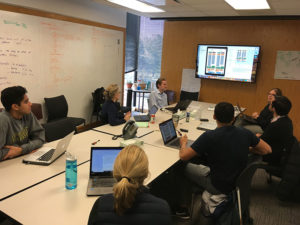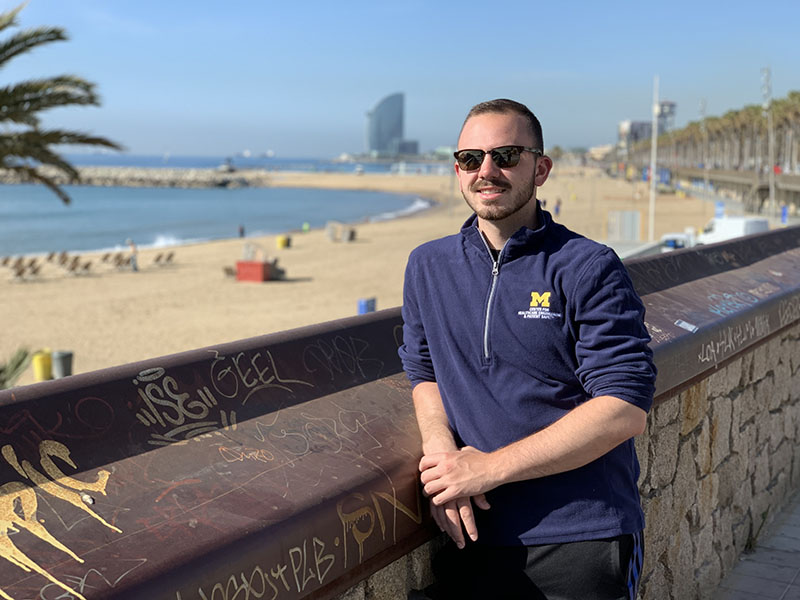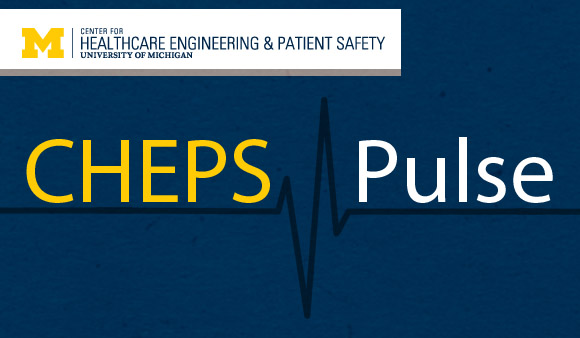In This Issue
Quantifying Collaboration in the ICU
Recent News
Where in the World is CHEPS?
Quantifying Collaboration in the ICU
Collaboration is at the heart of our work at CHEPS. So, it’s fortunate but not surprising that, when Emily Boltey, a PhD student at the University of Michigan Nursing School, decided to conduct research on interprofessional collaboration in the ICU, she found her way to CHEPS. Emily had observed in her work that many errors originate from problems in the system, not individuals. She understood that one way to address this was to improve teamwork and collaboration.
“In research we often say, you can’t really improve a process unless you can measure it and determine its effects,” said Emily. Much of the previous work on collaboration in the healthcare setting has been survey-based. However, this is not an accurate way to measure the collaborative process and Emily wanted to try another approach. “I am doing a time-motion study. Time-motion methods come from industrial and operations engineering and were basically created to quantify processes in industry,” she explained.
Time-motion studies have been used in healthcare more generally, for example, to look at the effect of electronic health records on processes. “I’m taking it a step further and saying can we use it on a more micro-process like collaboration,” Emily said. However, this wasn’t something she could achieve entirely on her own. “I said ‘I think I can only do this if I can get someone to help me make a tool to collect the data.’”

Luckily, Emily is part of the Hillman Scholar’s program and had, as an undergraduate, heard about CHEPS and the Center’s interest in partnering with collaborators in nursing from CHEPS Associate Director Amy Cohn at one of the program’s seminars. The idea of nurses and engineers collaborating to solve real-world problems in healthcare had stuck with Emily. As she pursued her PhD, CHEPS came to mind as the ideal place to find collaborators who could help her with a data-collection tool to study collaborative behaviors in the ICU. She got in touch with Dr. Cohn who was able to connect Emily with CHEPS students Abhi Bukkapatnam and Neil Gollapudi as well as CHEPS researcher Billy Pozehl. Abhi helped with application design and testing, Neil coded the application, and Billy consulted on data organization.
“It was a really interesting learning process for all of us involved,” Emily said. “A lot of it, in the beginning, was really about developing the usability of the app. So I came in with, in my head, a very distinct purpose of what I needed this app to do. But they asked ‘How do we make it usable to someone who just picked it up for the first time?’”
“Because the process of collaboration is pretty unpredictable and things can happen back to back, one of the things that was pretty important to me was that I needed to be able to capture things right after one another so we needed to have a screen that had the option to toggle between two sides of the screen,” Emily said. “So that was something unique that we had to be inventive about, thinking about things like how are we going to scale it so you can see both sides and it’s still usable.”

Creating the app took nearly the whole Fall 2018 semester to complete with the back end process of how to store and access the data taking more time than the front end design. When the team had trouble with accessing the data, they connected with Erkin Otles, an MD/PhD student in the Medical Scientist Training Program and Industrial and Operations Engineering. He helped them develop a function that would send the data to the user by email.
Emily was able to start data collection in the Winter 2019 semester. She trained two research assistants, in addition to herself, to use the app and together the team collected over 60 hours of observational data from one ICU while shadowing nurses, physicians, and respiratory therapists. “The app really streamlined the process,” she said. While they were finalizing the app, she did the first week of observations on paper herself. Emily found that collecting the data on paper was challenging because it made it difficult to accurately capture rapid interactions. “I thought, if this app doesn’t work, I don’t know what we’re going to do because it was so difficult to do by hand. The app has changed the trajectory of the project.”
The app allows users to record the behaviors that enable a collaboration to happen as well as the collaborative activities themselves, things like information exchange, troubleshooting, and offering help. And, because everything in the app is time-stamped, the app also allows users to look at sequences and patterns in collaborations and compare differences in these types of interactions.

Emily and her team found that nurses, physicians, and respiratory therapists use enablers and collaborative activities very differently which suggests there is not a one-size-fits-all approach to collaboration. Emily is hoping the tool can be used to collect more data in the future. “I think it’s something that could be potentially refined moving forward and applied on a larger scale,” said Emily.
Recent News
- Karmel Shehadeh has Paper Accepted for Publication in the European Journal of Operational Research, 6/14/19
- Anna Learis Gives Lunch & Learn on Personal Finance & Seasonal Eating, 6/12/19
- CHEPS Volleyball Tournament, 6/11/19
- Hannah Strat Attends Michigan Israel Engineering Trek, 6/10/19
- Alum Rachel Moeckel Returns to CHEPS for Lunch & Learn, 6/5/19
- CHEPS Students Attend IHPI Lunch & Learn, 6/4/19
- Jim Bagian & Joe DeRosier Deliver RCA2 Training, 6/4/19
- CHEPS Students on Michigan Rowing Team Help Capture Two Bronze Medals, 6/2/19
- CHEPS Students Visit Detroit, 6/1/19
- Billy Pozehl Shares Excel Tips and Tricks at Lunch & Learn, 5/31/19
- Julie Rovner Presents IHPI Directors Lecture, 5/31/19
- Justin Rogers and Theodore Endresen Present Lunch & Learn on Dermatology and Block Scheduling Projects, 5/29/19
- Precision Health Symposium, 5/29/19
- CHEPS Baby Photo Social, 5/24/19
- Adam VanDeusen Delivers Lunch & Learn on Literature Reviews, 5/22/19
- Merrill Bonder Visits CHEPS, 5/17/19
- Trevor Hoffman and Hannah Strat Give Lunch & Learn on Glaucoma and Surgical Instrument Projects, 5/15/19
- CHEPS Summer Kick-Off, 5/14/19
Where in the World is CHEPS?

Ryan, a U of M IOE alum working with us here at CHEPS, is pictured on the beach in Barceloneta which is just outside the old city in Barcelona! He traveled there for a week with his parents at the end of May. He said there was “Lots of food, lots of walking, so much fun.”
See more “Where in the World is CHEPS?” at our webpage.
Center for Healthcare Engineering & Patient Safety | University of Michigan
[email protected] | cheps.engin.umich.edu


